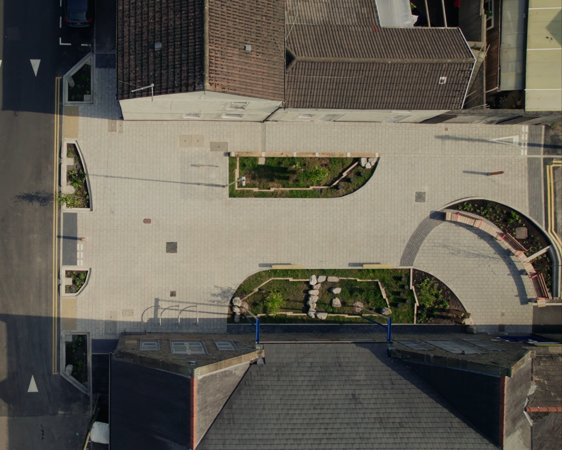Swansea’s rainscape project sets a new standard for climate-resilient communities

Flood prone urban space outside a Swansea primary school has been transformed into a vibrant, nature-based solution for managing rainwater, boosting biodiversity, and improving access.
Natural Resources Wales (NRW), in partnership with Swansea Council, Urban Foundry, and the Sandfields community, is proud to mark the completion of the transformative RainScape project at St Helen’s Primary School.
This pioneering scheme, designed by Robert Bray Associates, reimagines how urban spaces can manage rainwater, support biodiversity, and create safer, more accessible routes for walking and cycling.
The project has delivered 12 rain gardens, permeable paving, and playful features designed with and for the community. It has provided nature-based solutions that slow, clean, and absorb rainwater, reducing flood risk, easing pressure on combined sewers, and improving water quality downstream.
Fran Rolfe, Green Infrastructure Specialist, NRW, said:
“RainScape Swansea shows what’s possible when communities and partner organisations come together. It’s not just about managing water, it’s about creating places where nature and people thrive side by side. We hope this sets the tone for similar projects across Wales.”
The scheme also improves access to St Helen’s School for the first time in 150 years, with inclusive design features that reflect the needs of local families. Raised timber edges, bee habitat posts, and biodiverse planting create a space that’s educational, functional, and beautiful.
Andrew Stevens, the council’s Cabinet Member for Environment and Infrastructure, said:
“This project is a great way of enhancing local communities, encouraging civic pride and developing better sustainable transport links for local people. It’s a fantastic model for how we can tackle flooding, promote active travel, and build climate resilience in a way that’s fun, inclusive, and community-led.”
Dr Ben Reynolds, Director of Urban Foundry, said:
“Urban Foundry worked closely with NRW, Swansea Council and the community to make this project a success. This partnership was key - combining expertise with local knowledge and creativity. We involved children, teachers and families from the very beginning and created something that not only manages rainwater but also strengthens the connection between people and nature. This kind of collaboration shows how much more we can achieve together for climate resilience and community wellbeing.”
The community played a central role throughout, from shaping the design to celebrating the final touches.
For local parent Amina Yusuf, the impact is already being felt. She said:
“Before, it was just a blocked road and a giant puddle. Now it’s a peaceful, beautiful space where my kids can play and I can catch my breath after work. It’s made a real difference to our daily lives.”
As Wales continues to face the challenges of climate change, RainScape Swansea offers a blueprint for how urban design can adapt for climate change, nature and the community.
This scheme was funded by Welsh Government with support from Transport for Wales through the Active Travel Grant, Welsh Government‘s Local Places for Nature Funding, NRW-delivered Welsh Government Water Capital Programme and Wates (correct) Family Enterprise Trust.
